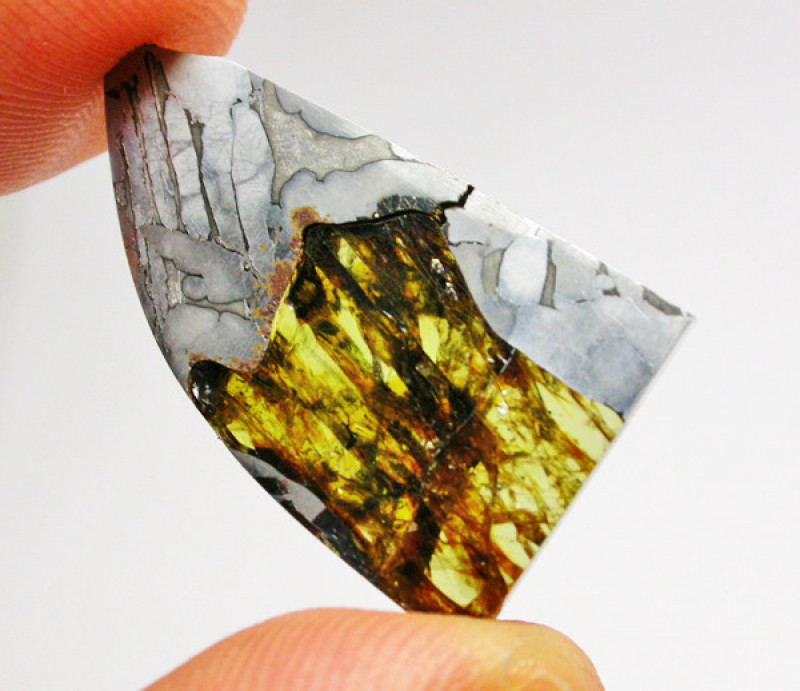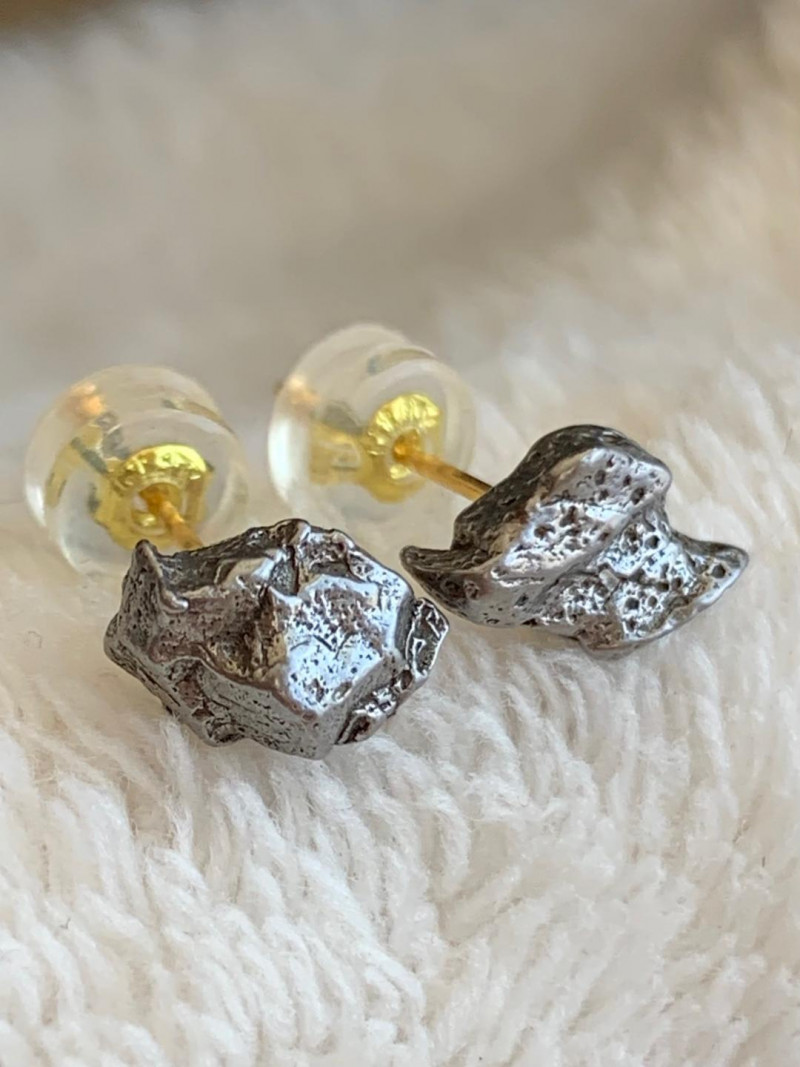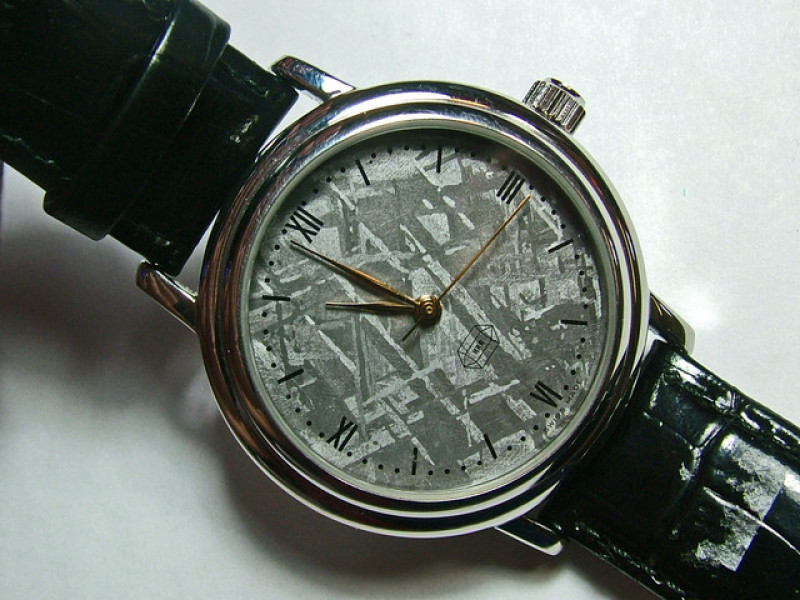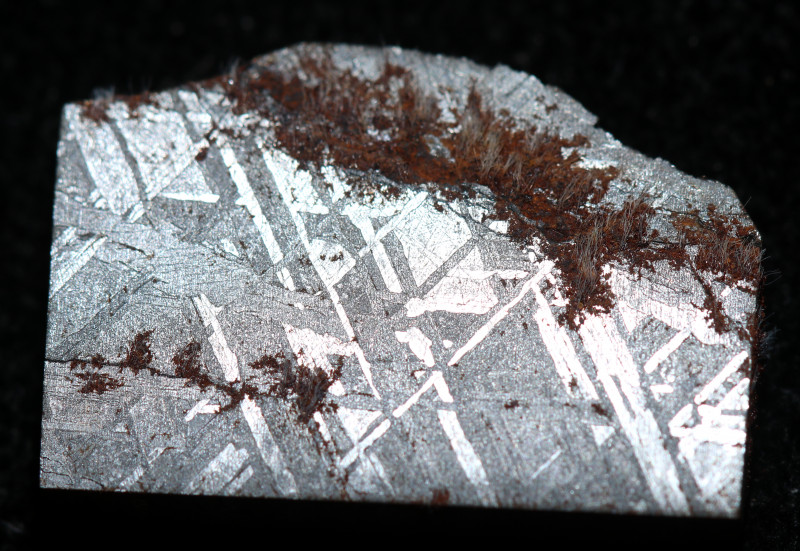
Meteorite Gemstone: Properties, Meanings, Value & More
 Meteorite is a rock or metal fragment from space used as a gemstone or decorative material. The scientific meteorite definition is a piece of space debris that entered our planet’s atmosphere and landed on Earth’s surface.
Meteorite is a rock or metal fragment from space used as a gemstone or decorative material. The scientific meteorite definition is a piece of space debris that entered our planet’s atmosphere and landed on Earth’s surface.
While most gemstones come from Mother Earth, others travel from the great beyond. If you’re wondering what stone is from space, meteorite is just one option, although it often contains other gems.
But wait, is meteorite a gem? Technically, no. Meteorites are classified as rocks or metals. However, jewelers use meteorite stones in jewelry and ornamental pieces.
Read on as we hitch our wagon to a star and endeavor to the great beyond to explore meteorite properties, uses, jewelry, and more!

What Is a Meteorite Stone?
Meteorites are dark brown or black and usually smooth-surfaced stones, but are sometimes dimpled.
Meteorite isn’t a birthstone, but some meteorites contain an August birthstone: peridot! Peridot forms naturally on Earth, but a few meteorites have carried peridot crystals, nicknamed “space peridot” or “extraterrestrial peridot.”
Astrologically, meteorite’s galactic origins make it a zodiac stone for every sign!
Identifying your zodiac sign is simple enough, but what about meteorite identification? Let’s go over the qualities to look for.
Meteorite Characteristics & Identification
Despite roughly 6,100 meteorites coming to Earth annually, approximately only about ten are found every year. So how do I know if I found a meteorite?
Start with a few questions:
Is it heavier than it looks? Meteorites are unusually heavy for their size.
Does it attract a magnet? The high iron content makes meteorites magnetic, though you may need to hang the magnet by a string for “stony” meteorites (which we’ll discuss next).
Does it have a flaky, eggshell-like crust? You may need to file down a corner to see, but meteorites will have metal flakes and a lighter-colored interior.
Is it glassy or opaque? If it’s glassy, it’s not a meteorite.
On the Mohs mineral hardness scale, meteorite ranks between 4-6, similar to fluorite. What kind of stone is meteorite, though? Over 90 percent of meteorites are rocks.
So, what is a meteorite made of? Meteorites are diverse but always fall under one of three categories.
Types of Meteorite Stones
Can you guess how many meteorites have been found on Earth? The answer: over 60,000! So, what are the three types of meteorites? We’ll break them down from most to least common.
Stony Meteorites
 (Image credit: By Gabisfunny - Own work, Public Domain, https://commons.wikimedia.org/w/index.php?curid=3351601)
(Image credit: By Gabisfunny - Own work, Public Domain, https://commons.wikimedia.org/w/index.php?curid=3351601)
Stony meteorites are mostly silica or silica minerals, but they also contain nickel and iron. According to NASA, around 94 percent of meteorites are stony.
There are two subcategories under stony: chondrites and achondrites. The main difference is that chondrites contain chondrules (tiny rock spheres).
Iron Meteorites
 Around five percent of meteorites are iron meteorites. These are almost entirely metal, mostly iron with nickel and traces of heavy metals like lead or chromium.
Around five percent of meteorites are iron meteorites. These are almost entirely metal, mostly iron with nickel and traces of heavy metals like lead or chromium.
Stony-Iron Meteorites

Lastly, about one percent of meteorites are stony-iron. Their composition is almost 50/50 of metal and silica.
Stony-iron has two subtypes: mesosiderites and pallasites. Both are rare, with only about 45 known pallasites and 50 known mesosiderites.
Mesosiderites are brecciated, made up of rock fragments and magnesium-rich silicate gems. Their iron-nickel content can range from 17-90 percent, and the metallic sections or flakes create a gorgeous contrast against their dark background.
Pallasites have shiny nickel-iron holding yellow-green olivine inside.
Can a meteorite have crystals? When the olivine is transparent and well-colored, you’re looking at the semi-precious gemstone peridot!
Peridot crystals aren’t the only gemstones from space, though!

Types of Meteorite Crystals
You may have wondered: Do meteorites have gems? Sometimes, yes!
It’s pretty rare to find gem-quality meteorite crystals, mainly because the heat and crash landing often destroys any gemstones inside. If there are still facetable gems inside, it’s one-in-a-million!
Besides the green meteorite crystal peridot, opals from Mars have also come to Earth via meteorites! Plus, some researchers think carbonado diamonds probably formed from explosions in space, then came to Earth on asteroids or meteorites, scattering across early Mesozoic Pangaea.
Some gemstones form through meteorite impacts. Tektite is a unique black meteorite crystal formed when meteorite minerals and Earth minerals melt together at the impact site.
The dark green gemstone moldavite is another variety of tektite. Another gemstone brought to Earth via meteorite around 50,000 years ago is moissanite!
Meteorites can carry some beautiful gems, but they also make gorgeous jewelry stones themselves! Check out the rest of meteorite’s properties below.
Unveiling a Cosmic Marvel: The NWA 7401 Meteorite!
In a stunning celestial twist, the Earth has been graced by an extraterrestrial visitor unlike any other—NWA 7401, an Enstatite chondrite EL-melt rock. This is no ordinary space rock; it belongs to an exclusive club, representing just 2% of meteorites that embark on a journey to our planet.
Through an exhilarating expedition of scientific analysis, comparing it against the vast library of geological and meteoritic knowledge, we've uncovered its true identity. NWA 7401 isn’t just a space traveler; it’s a member of the esteemed ENSTATITE CHONDRITES, standing apart from the more common chondrites.
Dive into its makeup, and you’re in for a cosmic spectacle! Dominated by orthopyroxene and secondary plagioclase, with grains as large as 100 microns, this meteorite is a microcosm of outer space wonders. It's a storied archive of the universe, with relic chondrules and elongated radial pyroxene crystals, frozen in time. The meteorite's character is further enhanced by the presence of troilite, daubréelite, and kamacite, like stars in the night sky.
But the tale doesn’t end there. The grain boundaries of this celestial artifact are adorned with sulfates and oxides, silent witnesses to its journey through the unforgiving expanse of space.

In this thrilling journey of discovery, the enigmatic NWA 7401 has revealed its true nature, confirming its place among the stars as a celestial gem. It’s not just a fragment of the universe; it's a messenger from the cosmos, whispering secrets of the vast, starry unknown to our earthly realm.
Meteorite Specifications & Characteristics
Color: Gray, brown, black, or a combination of these; Interior is lighter-colored and may show a chrome-like shine
Crystal structure: Octahedrite (part of Widmanstätten pattern) or hexahedrite - both only in iron meteorites
Luster: Dull, metallic, or submetallic
Transparency: Opaque
Density: 8.00
Cleavage: None
Fracture: Steely (only iron meteorites)
Streak: Brown, brownish-orange, or none
Luminescence: Sometimes phosphorescence in orange, green, or yellow-white; Sometimes fluorescence in yellow, red, or blue
Phew, that was a lot of science. On the more spiritual side, what does a meteorite represent?

Meteorite Gemstone Meaning
Let’s look at the meaning behind the meteorite crystal’s name.
The word “meteorite” comes from the Greek meteōros, meaning “high in the air” or meteoron, meaning “phenomenon in the sky.” Pretty straightforward, right?
Many ancient societies believed meteorites were sacred, often claiming they came from the heavens and held supernatural power.
Before we knew how magnets work, it was considered supernatural. Therefore, meteorites’ magnetic properties only strengthened their heavenly associations.
Even though moldavite doesn’t travel on meteorites, it’s often considered the most powerful meteorite stone. It historically served as a lucky amulet, even rumored to grace the Holy Grail.
Forming on Earth roughly 50 million years ago, ancient and modern crystal healers believe moldavite was sent to mankind to transform their spirits.
On that note, what does meteorite help with?

Meteorite Healing Properties
All gemstones can function as healing stones by nature of their coloring and internal energies.
Younger meteorites are usually black, granting them the healing properties of other black gemstones: grounding, fertility, and protection.
Older meteorites usually become reddish-brown. Brown meteorite stone benefits encompass the stability, strength, and comfort of other brown gemstones.
What about meteorite crystal properties for physical, emotional, and chakra healing?
Physical Healing
On the physical side, crystal healers use iron meteorites for purifying blood, increasing vitality, and bringing better physical balance. Ancient cultures believed these stones could improve fertility, too!
Emotional Healing
Meteorite stones are said to support spontaneity and spiritual awareness. Some say these stones manifest fortunate encounters, bringing lifelong friends or partners.
Chakra Healing
Chakra healing means opening your chakras, seven energy centers along your spine tied to emotional and physical symptoms. Gems can function as chakra stones, aligning your energies or clearing a blocked chakra.
Meteorite is a chakra stone for multiple chakras, but it’s most effective for the third-eye chakra. Migraines, inattention, and aimlessness are all symptoms of a blocked third eye. After using meteorite, your now-opened third-eye chakra will bring you feelings of spiritual connection and intuition.
Wearing a meteorite is one method of chakra healing! Of course, you’ll need to buy it first, so let’s go over what to look for when shopping.

Meteorite Gemstone Properties
Unlike other gems, meteorite’s rare occurrence and origins are its main selling points. But, some typical gemstone properties factors can affect its value, namely cut, clarity, and color.
Cut: Meteorites are durable enough to handle both faceted cuts and unfaceted cuts. Common unfaceted cuts for meteorites include cabochons, beads, or slices.
Color: Meteorite’s inclusions can give it different colors and sometimes patterns. You already know about chondrules, but inclusions of calcium and aluminum can create a light-and-dark contrast against the dark iron.
With that in mind, what stellar accessories is meteorite used in?
Meteorite Jewelry
Most real meteorite jewelry contains iron meteorites fashioned into stones or metal settings.
The meteorite’s size usually dictates the jewelry type. For instance, a smaller piece is perfect for a meteorite gemstone ring, while larger pieces make show-stopping pendants.
Some iron meteorites have natural patterns, which jewelers may enhance by giving the stone an acid bath. You may see meteorite watch faces or bands, often created with cross-section slices of this naturally patterned meteorite.
The rarer stony-iron meteorites may also be cut into slices, displaying a colorful matrix of green and yellow silicate gemstones encompassed in iron. These slices create a truly head-turning meteorite necklace!

Meteorite History
Meteorites have led to valuable insights into the universe’s history, including Earth!
Scientific analysis shows most meteorites likely formed early in our solar system’s history, but meteorite ages range from 200 million to 4.56 billion years old.
As far back as 3,500 BC, ancient societies incorporated meteorites into accessories, tools, and talismans. Some examples are a meteorite bead from an Egyptian burial site and a meteorite dagger found in King Tut’s tomb.
Surprisingly, scientists didn’t believe meteorites came from space until 1803!
Most “rational thinkers” of the 1700s chalked up sightings to tall tales until Jean-Baptise Biot, a French physicist, published his report on the l’Aigle meteorite fall. Combining eyewitness accounts with scientific proof that the rocks weren’t from Earth, Biot established the study of meteorites.
The most recent meteorite sighting was on October 3, 2021, when one crashed through a Vancouver woman’s ceiling onto her bed, narrowly missing her head!
Before it lands on Earth — or in a Canadian bedroom — how does a meteorite form?

Meteorite Origins & Sources
Every variety forms slightly differently, but the majority (stony meteorites) are believed to come from the asteroid belt as pieces of asteroids fall out of their original orbit and into Earth’s.
Iron meteorites form pieces of destroyed planets, dwarf planets, large moons, or asteroids. When one of these planetary bodies is destroyed, its core breaks off into iron meteoroids. The meteoroids that landed on Earth are then classified as meteorites. Meteoroid, meteor, and meteorite all describe the same object at different stages in its travel through space.
Stony-iron meteorites are created from either a) excess debris (stuck together) from when our solar system formed or b) crust fragments from moons, planets, or asteroids.
When they finally make it to us, where are meteorites found on Earth?
Mining Locations
Meteorites fall indiscriminately worldwide, but deserts are the most common environment for finding them. In fact, more meteorites have been found on one continent than all other continents combined: Antarctica!
Antarctica is considered a desert (since it has little rainfall), and expeditions have recovered almost 42,000 meteorites there!
Other prominent, known locations for fallen meteorites are:
Argentina
Chile
China
Mexico
Namibia
Russia
USA
Finding a meteorite is one-in-a-million, so how much is a meteorite worth?

Meteorite Price & Value
With a combination of scarcity and unique origins, meteorite value can be high, but it isn’t always. Average meteorites can range anywhere from $0.50-$1,000 per gram — it depends on the quality, location, and availability of the particular meteorite.
Remember, meteorites are dense; a meteorite the size of a golf ball will typically weigh about 4x more. Therefore, a low price-per-gram can quickly add up when you take size and weight into account.
Here’s an average meteorite price list at wholesale costs:
Iron meteorite: Around $2 per carat ($10 per gram)
Kenyan pallasite slice: $10-$25 per carat ($50-$125 per gram)
Australian pallasite slice: $20-$30 per carat ($100-$150 per gram)

Meteorite Care and Maintenance
Considering the unknowns of space, is it safe to wear meteorite?
Yes, meteorite is safe to wear. In fact, humans pose a more significant threat to meteorites’ safety! From contamination to easy scratching, meteorites are pretty fragile. Jewelers must follow strict procedures to prevent damage.
If a meteorite for sale is properly prepared, it may be pricier. However, you’re paying for the stone to last much longer.
Some procedures for preparing a meteorite include storing it in a moisture-free display case, handling it with clean cotton gloves, and regularly cleaning it with the proper method.
To clean a stony meteorite, use a toothbrush to wipe away dirt or dust, thoroughly wipe the stone down with a clean rag soaked in pure alcohol (at least 95%), and let it air dry.
Here’s how to clean an iron or stony-iron meteorite, particularly rust spots:
Soak a Q-tip in calcium, lime, and rust remover (CLR).
Gently press the soaked Q-tip onto each rust spot, carefully wiping away the rust at each spot.
Rinse the stone with pure alcohol (at least 95%) by either placing it in a container and pouring the alcohol over it, wiping it with an alcohol-soaked cloth, or using alcohol-soaked Q-tips. You may need to use a toothbrush to make sure all the CLR is gone.
Let the stone air-dry.
Leave the stone submerged in Automatic Transmission Fluid overnight.
With clean cotton gloves on, take the stone out and use a clean rag or paper towel to remove excess oil.
To make your meteorite last, avoid contact with acids and household chemicals and store it in dry air at a constant temperature.
Ready to find the perfect meteorite crystal for sale?

On the Hunt for a Galactic Gem?
Space has captured our sense of adventure for decades. Similarly, meteorites have captivated both scientists and crystal lovers, encouraging exploration of the unknown. A meteorite crystal in hand will encourage you to push boundaries and follow your curiosity.
As novelist Jack London said: “I would rather be a superb meteor, every atom of me in magnificent glow, than a sleepy and permanent planet.”
Search the Gemstone Encyclopedia
Related Auctions
Related Articles
Originally the Birthstones or gemstones were associated with a zodiac sign or the month of a individuals birth. Find out what your stone is and view the stones we have for sale
8th Feb 2021
There are dozens of quartz and chalcedony gems with various colors and patterns. Learn all about quartz properties and every type of quartz, from amethyst and agate to plasma and phantom quartz!
15th Oct 2020
Hackmanite is a pink to violet sodalite gem known for its unique color-change and luminescence. Learn why hackmanite is special, from its rare qualities to the types of hackmanite jewelry available.
28th Mar 2018
Latest Articles
Yugawaralite is a rare colorless, white, or pinkish zeolite crystal named for its discovery in Yugawara, Japan. Here we uncover the multifaceted history, properties, prices, and uses of yugawaralite.
24th Mar 2025
Simpsonite is a lesser-known mineral known on the gem market for its durability, yellow-orange color, and rarity. Discover all the properties, uses, prices, and history of simpsonite.
3rd Mar 2025
Kurnakovite is a colorless crystal related to inderite and rarely faceted but known among collectors. Explore the mineral traits, history, prices, and more in this kurnakovite guide.
17th Feb 2025
Article Categories
How To's is where you will find helpful articles from gem Rock Auctions on how to cut gemstones, select gemstones and buy gemstones.
9 Articles





